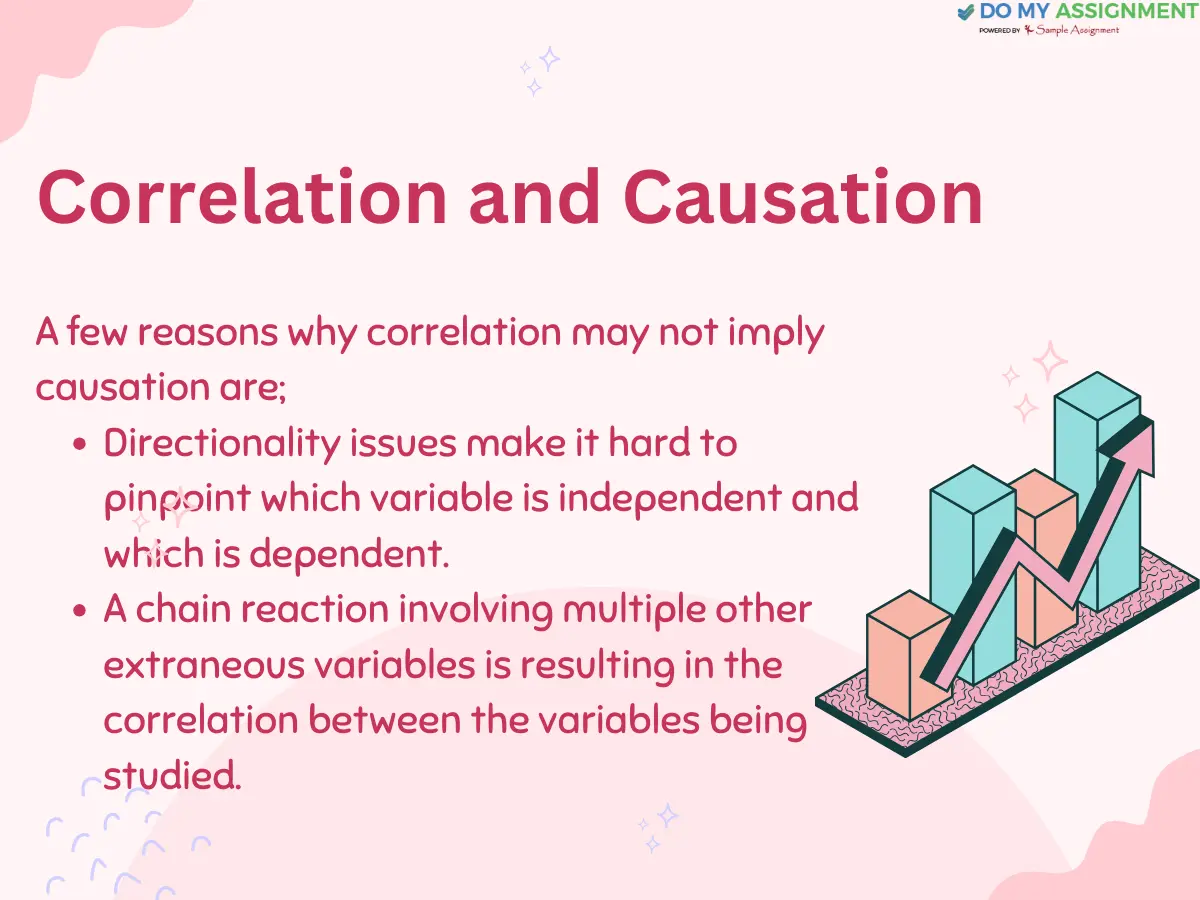An Overview of Correlation and Causation

Highlights
Causation and correlation are two similar ideas with different qualities. It is essential to comprehend these differences to assess and interpret scientific studies appropriately. It is crucial to know the difference between correlation and causation to grasp the interactions between variables.
The principles of correlation and causality are fundamental to many fields, such as environmental science, marketing, healthcare, finance, and education. They offer insightful information for determining the best action for investments, assessing treatment efficacy, deciphering consumer behaviour, and analyzing environmental effects.
Therefore, to draw reliable findings in these various sectors, it is imperative to comprehend the difference between correlation and causation.
While pursuing a degree in data analysis or any other course where statistics is a prime subject, students get assignments on correlation and causation. If you are pursuing such a course and are facing challenges while doing these tasks, you can reach out to us at ‘Do My Assignment’.
We have a team of highly qualified writers who perform exceptionally well in their respective fields of expertise.

However, read this blog to learn some basic concepts about the topic that can help you complete your assignments independently. So, let’s dig in and find out more.
Correlation and Causation
For those seeking a concise explanation of the difference between correlation and causation, the following help:
Two variables are said to be correlated when they change in pair with one another.
If anything can be rationally explained as to why it is happening, then causation has taken place. It implies a link between cause and consequence.
Correlation
In statistics, the term "correlation" refers to the relationship between two variables whereby a change in one causes a change in the other. However, it's important to remember that this connection may not always indicate a cause-and-effect relationship between the factors.
Three primary categories exist among variables:
1. Positive Correlation
This indicates that two variables are moving in the same direction when their correlation is positive. Y grows in response to increases in X, while Y drops in response to reductions in X.
2. Negative Correlation
This indicates that the variables move in opposition to one another. Y falls when X rises and increases when X falls.
3. Lack of Correlation
The absence of correlation indicates a lack of relationship between variables. Y either doesn't change or doesn't follow any clear pattern when X rises.
To prevent deriving incorrect conclusions from statistical analysis, it is crucial to comprehend the difference between correlation and causation. Analysts may more skillfully assess data and make defensible judgments based on the findings based on various kinds of correlations.
Causation
When two variables are related, they are said to be in a cause-and-effect relationship. This term is used in the analytics domain to describe this relationship. Moreover, the dependent variable changes as a result of this relationship with an independent variable.
For instance, in the colder winter months, sales of blankets and room heaters in the previously mentioned case exhibit a favourable link. But the temperature and each of the two variables alone have a causal link. The number of individuals buying blankets and room heaters increases in tandem with temperature decreases.
This demonstrates the idea of causation, wherein changes in the dependent variables (sales of blankets and room heaters) are caused by changes in the independent variable (temperature). It is significant to remember that determining the precise source of a dependent variable can be challenging because it might be influenced by a variety of circumstances.
Making defensible judgments based on data analysis requires an understanding of causation in analytics. Analysts can separate the variables that lead to particular results by establishing causal links.
If concepts related to correlation are unclear to you and it hampers your assessments’ quality, get assessment help from us. Our professionals have in-depth knowledge of the same and can deliver remarkable results for your assignments and assessments.
Correlation vs Causation
To accurately analyze data and make statistical conclusions, one must comprehend the difference between correlation and causality:
Changes in one variable are correlated with changes in the other, which is known as a correlation between two variables. A positive or negative correlation indicates that two variables tend to move in the same direction. The two variables rise or fall together when there is a positive association. As one variable falls, the other rises, and vice versa, in contrast to a negative correlation. Interestingly, correlation does not imply causality; it just shows a link between variables.
Contrarily, causality explains how two variables are related to one another through cause and effect. Adjustments to one variable directly affect adjustments to the other in a causal relationship. A correlation alone is not sufficient to establish causality. Excluding the potential of extraneous factors or random events contributing to the observed correlation is necessary to prove unequivocally that one variable affects the other.
In summary, causality, correlation, and summation are unrelated ideas. A cause-and-effect link is demonstrated by causality, while correlation characterizes the relationship between two variables.
Does Correlation Imply Causation
It is inappropriate to deduce causation from correlation for several reasons:
1. Third-Variable Confounding
An association between the two variables under study will occasionally result from a third variable. In these cases, the third variable influences the other two variables independently, implying that there is no cause-and-effect relationship between the variables under consideration.
2. Directionality Problems
There are directionality problems in some situations when variables do have a causal link. This indicates that it is difficult to determine which variable is "the effect" (also referred to as the dependent variable) and which is "the cause" (also referred to as the independent variable). In those circumstances, we are unable to infer causality because the causal relationship cannot be demonstrated.
3. Chain Reaction
Several distinct factors could be affecting the way the two variables under study are correlated. This cascade of events suggests that the variables are only associated with one another rather than having a cause-and-effect connection.
Explore the Difference Between Correlation and Causation
Understanding the difference between correlation and causation is essential, as it is crucial to know how it influences our way of interpreting data. Wrong inferences and misdirected information might result from assuming causation when there is a mere correlation. Through the following key points, it will be straightforward for you to identify both concepts when and where they are applied.
1. Type of Relationship
Correlation: A statistical relationship between two variables is indicated by a correlation, which illustrates how they frequently change in sync.
Causation: A change in one variable directly affects the occurrence of another, which is known as a cause-and-effect relationship.
2. Direction of Influence:
Correlation: Two variables may influence one another or be altered by an outside source; correlation does not indicate the direction of influence.
Causation: One variable acts as the cause, and the other as the effect in a directional relationship, which is described by the concept of causation.
3. Third Variables
Correlation: When two variables are correlated, it can happen by coincidence or be the result of a third variable's influence without being the cause of the other.
Causation: To establish a direct cause-and-effect link, it is necessary to rule out the influence of third factors.
4. Temporal Sequence
Correlation: When two variables change concurrently or in a different order, correlation is unnecessary to indicate a temporal sequence.
Causation: The cause must come before the effect in a particular temporal sequence for there to be causality.
5. Experimental Manipulation
Correlation: Naturally occurring data is the basis for correlation, which is observational and does not include any manipulation of the variables.
Causation: To determine causality, a researcher will usually manipulate a variable experimentally, changing one thing on purpose and then watching how it alters another.
It is important to comprehend these distinctions since inferring causation from correlation alone can be misleading. However, for a true cause-and-effect link to be established, more research and controlled tests are required. When doing data analysis, it is crucial to clarify the difference between correlation and causation. It's important to prove causation before making any inferences or taking any action, even though correlation can offer insightful information about the relationship between variables.
Conclusion
Since we're always searching for patterns, our first instinct is to interpret what we discover. But it's reasonable to assume we're just seeing correlation unless causality can be proven.
Until a direct and obvious connection can be established, events that seem related in common sense cannot be considered causative. Additionally, correlation does not always imply causation, even when the two might coexist. Even after understanding this difference, if you can’t handle your assignments, you can connect with us for exceptional assignment help. With the assistance of our supportive writer, you can excel in each of your academic writing tasks.
Nick Johnson
Nick is a multi-faceted individual with diverse interests. I love teaching young students through coaching or writing who always gathered praise for a sharp calculative mind. I own a positive outlook towards life and also give motivational speeches for young kids and college students.








